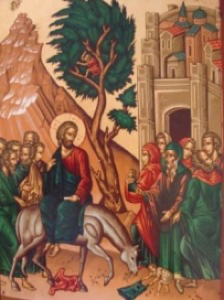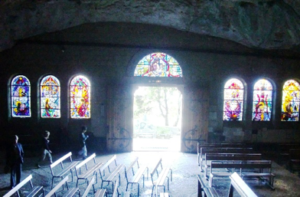By Christine Sunderland
 Today is Palm Sunday, a major festival in the Christian year. It recalls and celebrates Christ’s humble and glorious entrance into Jerusalem on a colt, to begin the week leading to Maundy Thursday, Good Friday, and Easter Sunday. As Jesus entered the gates of the city, the “multitudes” waved palms in greeting. They spread their garments and branches before him, to honor him. They expected a king but were given a suffering savior.
Today is Palm Sunday, a major festival in the Christian year. It recalls and celebrates Christ’s humble and glorious entrance into Jerusalem on a colt, to begin the week leading to Maundy Thursday, Good Friday, and Easter Sunday. As Jesus entered the gates of the city, the “multitudes” waved palms in greeting. They spread their garments and branches before him, to honor him. They expected a king but were given a suffering savior.
Just so, all creation is sacramentally intertwined with the story of birth, death, and resurrection. As Christian writers we do the same: we create living sacraments called books. Our books contain pages that contain words. These are outward and visible signs of inner and spiritual graces. Sacraments make the invisible visible, revealing God to man, Creator to creation, linking us. Our inked words on paper or screen enliven people and places and events, for they are realized in our imaginations, making them visible.
Keeping these miraculous truths in mind, we infuse our earthy words with heaven. We raise a Jacob’s ladder for our readers to climb, so that they experience God in our pages, with settings mirroring heavenly truths. In a sense, each rung the reader climbs is a chapter leading to truth about Man and God.
And thus, while the actions of my characters inform the plot – a spiritual struggle leading to a climax and resolution, hope-full of grace – the places in which they find themselves reflect bits of heaven too. The details of the natural world are vividly portrayed in their drama and beauty, reflecting light or darkness, dawn or twilight. Leaves shimmer, paths beckon, thunder rumbles, lightning strikes, waters pour from cliffs and the heavens. We smell and see, touch and taste, and hear a melody from afar, just as Mary Magdalene did on that first Easter morning as she ran to the tomb, bearing sweet oils to anoint her Lord’s body.
cliffs and the heavens. We smell and see, touch and taste, and hear a melody from afar, just as Mary Magdalene did on that first Easter morning as she ran to the tomb, bearing sweet oils to anoint her Lord’s body.
Who was Mary Magdalene? I recently signed a contract with En Route Books and Media to re-issue one of my out-of-print titles, The Magdalene Mystery, originally published by OakTara in 2013. The story involves a young woman, Kelly Roberts, who searches for the historical Mary Magdalene on a quest devised by Kelly’s late godfather, a bequest meant to pull her deeper into her faith through first-century history and Gospel accounts. What did Mary Magdalene see on that first Easter morning? How do we know these accounts are true? How do we know history is true, especially claims of resurrection from the dead? Are there true reasons to believe?
My characters explore these questions in a journey threaded with suspense and intrigue. They set out for Rome, where they search for clues in basilicas, going back in time to early manuscripts and ancient cloisters. They begin to piece together the puzzle of perception, pulling the past into the present, so that the past touches our hearts and minds today. Just so, the present reaches to the past to make this happen. This touching and linking reflects our own reaching to touch Christ and be made whole, just as it reflects his reaching to us as the Good Shepherd.
 The second half of the novel is set in southern Provence, with visits to Marseille, Saint Maximin, and the Sainte Baume Sanctuary. The great Sainte Baume massif which straddles the coastline is home to a grotto where it is said Mary Magdalene spent her last days. The grotto is a sacramental setting, for a chapel has been created in the cave, with dripping rock walls embracing altar and pews and flaming candles. The natural world has been tamed by the spiritual, just as man tames passion with spirit, body with soul.
The second half of the novel is set in southern Provence, with visits to Marseille, Saint Maximin, and the Sainte Baume Sanctuary. The great Sainte Baume massif which straddles the coastline is home to a grotto where it is said Mary Magdalene spent her last days. The grotto is a sacramental setting, for a chapel has been created in the cave, with dripping rock walls embracing altar and pews and flaming candles. The natural world has been tamed by the spiritual, just as man tames passion with spirit, body with soul.
There is a path that leads to the La Sainte Baume grotto, about a forty-minute walk through the forest. It has become a pilgrimage for many. A pathway is also a sacramental setting, for it reflects our own journey through life, from birth to death and birth again. We journey in time, reaching to touch eternity.

La Sainte Baume Grotto
Sacramental settings help the author to invite the holy among us. We reach for heaven, rooted on earth. These settings offer the reader a glimpse of the created order, our place in it, and God’s actions among us. For the cross, rooted in and on earth, rises to touch heaven. The horizontal beam embraces mankind. We reach for the cross as Christ reaches for us.
The eternal shafts its light upon earth, streaming through windows onto stone altars, and our readers reach, like the Magdalene, for the pouring light, to see the risen Christ in the garden. In our pages our readers wave their palms and sing their hosannas. They too can join the entry into Jerusalem. They too can step through the gates of the holy city. They too can sing, “Hosanna to the son of David: Blessed is he that cometh in the name of the Lord; Hosanna in the highest.” (Matthew 21:9, KJV)
Christian novelists choose settings that reflect the sacramental nature of God and Man, infusing earth with heaven. @ChristineSunderland #ACFWBlogs #writetip #critiques #ACFWCommunity Click To Tweet Christine Sunderland has authored seven award-winning novels: Pilgrimage, set in Italy, Offerings, set in France, Inheritance, set in England, Hana-lani, set in Hawaii, The Magdalene Mystery, set in Rome and Provence (all Oaktara), The Fire Trail (eLectio), set at UC Berkeley, and Angel Mountain (Wipf and Stock), set on Mount Diablo, east of Berkeley. She serves as Managing Editor for the American Church Union and is a member of the Anglican Province of Christ the King. Visit Christine at www.ChristineSunderland.com.
Christine Sunderland has authored seven award-winning novels: Pilgrimage, set in Italy, Offerings, set in France, Inheritance, set in England, Hana-lani, set in Hawaii, The Magdalene Mystery, set in Rome and Provence (all Oaktara), The Fire Trail (eLectio), set at UC Berkeley, and Angel Mountain (Wipf and Stock), set on Mount Diablo, east of Berkeley. She serves as Managing Editor for the American Church Union and is a member of the Anglican Province of Christ the King. Visit Christine at www.ChristineSunderland.com.
